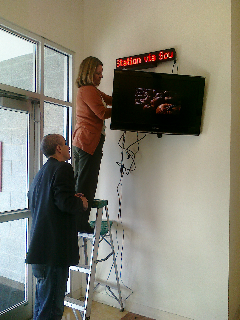 Lost in Boston Real Time turns bookstores and burrito joints into bus stops by delivering the MBTA’s live bus and T data to these value add locations via LED signs. The first few deployments of the project validated the hypothesis: indeed knowing that the CT2 is still ten minutes away is much more valuable while sitting at Anna’s Taqueria with friends than standing alone at the bus stop.
Lost in Boston Real Time turns bookstores and burrito joints into bus stops by delivering the MBTA’s live bus and T data to these value add locations via LED signs. The first few deployments of the project validated the hypothesis: indeed knowing that the CT2 is still ten minutes away is much more valuable while sitting at Anna’s Taqueria with friends than standing alone at the bus stop.
LIB Real Time may be of limited value to all of us with smartphones and bus apps. But imagine you’re not sitting at Anna’s with the bean juice running down your arm as you check your smart phone app; instead you’re a client living at a residential treatment program for drug and alcohol addiction.
Say today is the first day of a new job and you need to find your way there on the bus. You don’t have a bus schedule, never mind a smart phone. You leave for the bus stop hoping that today the cards aren’t stacked against you and the bus is running on time.
This is a reality for many of the 102 individuals living at Hope House in Boston’s South End. When residents are faced with the inevitable delays that come with their daily commutes via public transit, it creates an additional stress in an already challenging time in their lives.
Hope House understands that support and empowerment for their comprehensive community-based treatment program can come from many sources. So when Development Director Susan Bradley heard about Lost In Boston Real Time, she knew it would be a perfect fit for the residents of Hope House. She contacted creator Rick Borovoy last summer:
>Dear Lost in Boston team:
Would we be eligible to host a Real Time bus sign? Hope House is a non-profit residential rehab center for homeless men. We are located at the corner of Melnea Cass Blvd and Hampden Street. We have 102 residents, most of whom depend on public transportation. The #1 bus route is the one we would be interested in monitoring.
It turns out that Lost in Boston Real Time is uniquely positioned to support the residents of Hope House. And since partnering with Hope House, they have proven to be an ideal community collaborator: unwearied, bold and candid.
Unwearied: Hope House appreciates that Lost in Boston is a pilot project and is working out some kinks in its initial deployments. Hope House patiently and graciously waited until early November while a more reliable version of the software was developed before the signage and hardware were installed.
Bold: Hope House brings humor and a practical sensibility to the Lost in Boston project. Always willing to roll-up their sleeves, grab a ladder, and push a few buttons on the net book, Hope House takes sign administration in stride.
Candid: Straightforward, honest and direct, Hope House didn’t hesitate to let us know that the residents loved the sign and… when things weren’t working. Hope House also invited us to meet directly with residents -the end-users – facilitating an authentic and valuable feedback loop for the project.
Encouraged by the successful deployment of Lost In Boston Real Time at Hope House, the project is exploring new community partnerships. Upping the ante, this time around we’ll be seeking to build a system of signs within a community that combines real time event and public transportation information. Interested? Please contact Rick Borovoy at borovoy@media.mit.edu or Regan St. Pierre at reganstp@mit.edu here at the Center for Future Civic Media.
